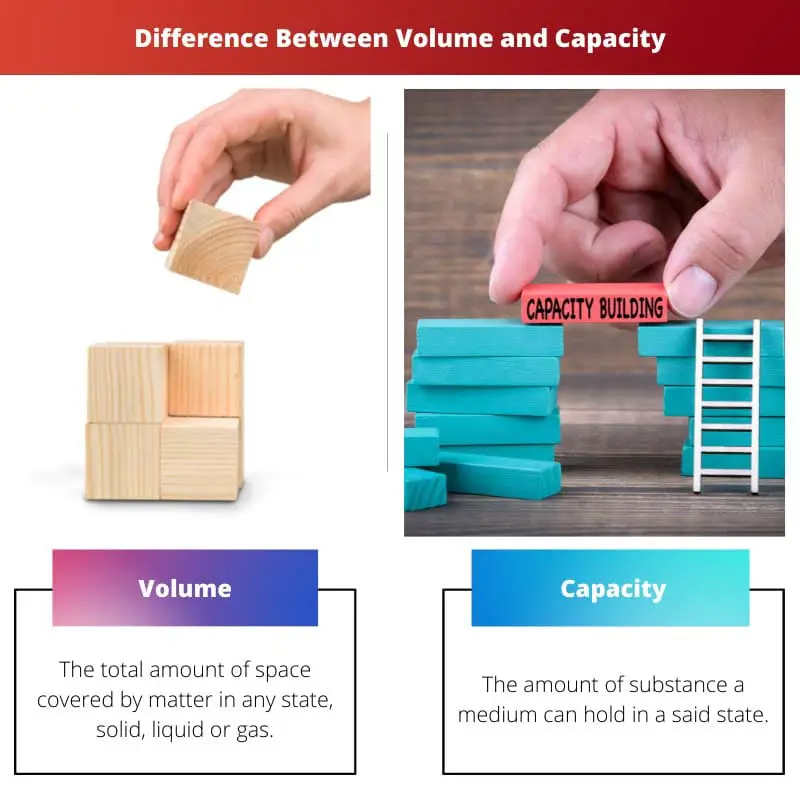There are distinct units of measurement for objects in day-to-day life. The system of measurement varies for 2-dimensional and 3-dimensional objects.
The two primary ways 3-d objects can be measured are volume ad capacity. Even though the terms are interchangeably used in day-to-day life, they are very different.
Key Takeaways
- Volume refers to the amount of space an object occupies, while capacity refers to the maximum amount a container or space can hold.
- Volume is measured in cubic units like cubic meters or cubic feet, while capacity is measured in units like liters or gallons.
- Volume is more concerned with the physical dimensions of an object, while capacity is more focused on the amount of material that can be contained within a specific space.
Volume vs Capacity
Volume refers to the amount of space occupied by an object in three dimensions, measured in cubic units such as cubic centimeters, cubic meters, or cubic feet. Capacity refers to the amount of substance that can be held or contained by a particular object or container, measured in liters or gallons.

Volume is the space taken up by a substance in any state, while capacity is the amount of importance a container or medium can hold.
For example, there is a glass with some water in it. The area occupied by the water, in this case, would be the volume. However, the amount of water required to fill the glass up to the brim ultimately will be its capacity.
Comparison Table
| Parameter of Comparison | Volume | Capacity |
|---|---|---|
| Definition | The total amount of space covered by matter in any state, solid, liquid or gas. | The amount of substance a medium can hold in a said state. |
| Meaning | It is the amount of the substance concerning space it takes up. | Potential holding capacity of an object. |
| Measurement | Volume is measured in cubic meters or cubic centimetres. | Capacity is measured in litres and gallons |
| Object | Any object, irrespective of state, can have volume as long as it covers space. | Capacity is a characteristic feature of hollow or porous objects. |
| Example | The amount of milk in a carton is the volume of the milk. | The maximum amount of milk required to fill up the carton is the capacity of the carton. |
What is Volume?
Mathematically, the volume is the space occupied by it or the amount of space it encloses. The importance of a substance can be calculated for a given sense if it exists in a regular geometric shape, for example, a cube, sphere etc., using assigned formulas.
The general formula for calculating the volume of an object is multiplying the height, width and length with each other. Integral calculus can be used to calculate the volume of specific irregular shapes.
One-dimensional and two-dimensional objects have zero volume. Volume is measured in cubic meters and cubic centimetres.
The term cubic signifies the number of cubes of the given unit that can be placed within the enclosed space.
Another technique used to calculate the volume of a substance is called fluid displacement. The principle of fluid displacement states that the volume of fluid displaced by an object, when immersed, is equal to the space occupied by the thing. Hence this becomes the volume of the object.
This technique is specifically helpful for measuring the volume of a solid object, especially if the shape is irregular.
The unit of volume can be derived from its corresponding unit of length. The book’s SI or International Standard Unit is cubic meter (c3).

What is Capacity?
Capacity refers to the ability of a substance to hold matter. The general term capacity can be applied to various places, indicating potential.
Mathematically capacity is the maximum amount of substance, fluid, that can be placed within the object.
Capacity in mathematics is closely related to volume. However, there is a slight difference in calculating volume and power. When calculating the ability of a container, only the hollow space is considered. Hence it is the amount of fluid required to fill the object; however, in the case of volume, the entire object, including the container’s dimensions, is considered.
The metric term used to express the capacity of a substance is litres, gallons etc. The conversion between litres and cubic meters is pretty simple.
Capacity is a characteristic feature of objects. It is the more frequently used term in day-to-day life.
The amount of product inside a bottle of shampoo we buy is listed in litres because you will be charged according to the cost of the shampoo, hence the capacity of the container matters.
To understand this in a better way, consider a thermostat bottle. Such bottles have multiple layers of thermostatic substance lined inside the walls of the container.
Such bottles have a smaller capacity than what any person would estimate based on the overall volume of the bottle.
Hence capacity is the fluid holding potential of an object.

Main Differences Between Volume and Capacity
- Volume is defined as the measure of the space taken by mass, while capacity is the fluid-holding potential of an object.
- The amount of area taken up by a substance at a given time is its volume, versus the amount of fluid required to fill up an object up to the brim is its capacity.
- Mathematically, volume is measured in cubic meters, whereas, Capacity is measured in litres.
- Volume can be calculated using fluid displacement, while capacity cannot be calculated by fluid displacement.
- Volume is a characteristic of the substance, while capacity is assigned to hollow container-like objects.

- https://journals.sagepub.com/doi/abs/10.3141/1581-06
- https://www.safetylit.org/citations/index.php?fuseaction=citations.viewdetails&citationIds[]=citjournalarticle_604385_38

The discussion on calculating volume and capacity using both regular and irregular shapes was intellectually stimulating. Impressive article!
Absolutely! The inclusion of different calculation methods expanded my understanding of volume and capacity.
The comparison table was a great addition to the article. It made it much easier to differentiate between volume and capacity.
Definitely! The comparison table was a handy tool in grasping the nuances of volume and capacity.
The real-world examples used throughout the article made the concepts of volume and capacity very relatable. Kudos to the author for a well-written piece!
I completely agree! The practical examples helped to solidify the understanding of these measurement units.
The distinction between volume and capacity is crucial, and this article did a great job of highlighting the differences.
Agreed! The article served as a comprehensive guide to volume and capacity.
Definitely! Understanding these concepts is fundamental to many fields, and this article laid out the information brilliantly.
I found the exploration of fluid displacement for measuring volume to be fascinating. It’s amazing how such scientific principles apply to everyday measurements.
Absolutely! The article brought a fresh perspective on everyday measurements and their scientific underpinnings.
I think the fluid displacement technique for measuring volume is an interesting approach. This article provided valuable insights into these measurement concepts.
I never knew about the fluid displacement technique. Learning something new every day!
Absolutely! The discussion on fluid displacement was quite enlightening and added depth to the topic.
The mathematical explanations really clarified the concepts. Great read!
I couldn’t agree more! The mathematical breakdown of volume and capacity was insightful and educational.
Very interesting article! The difference between volume and capacity has always been confusing for me, but this post cleared things up.
I agree! This article explains the concepts in a very clear and concise manner.
The difference between volume and capacity has never been clearer. This article surpassed expectations!
Indeed! It was an insightful exploration of these concepts, shedding light on their complexities.
I appreciate the detailed explanation of volume and capacity. It’s great to have a better understanding of these two measurements.
Definitely! I found the comparison table to be especially helpful in understanding the differences between volume and capacity.